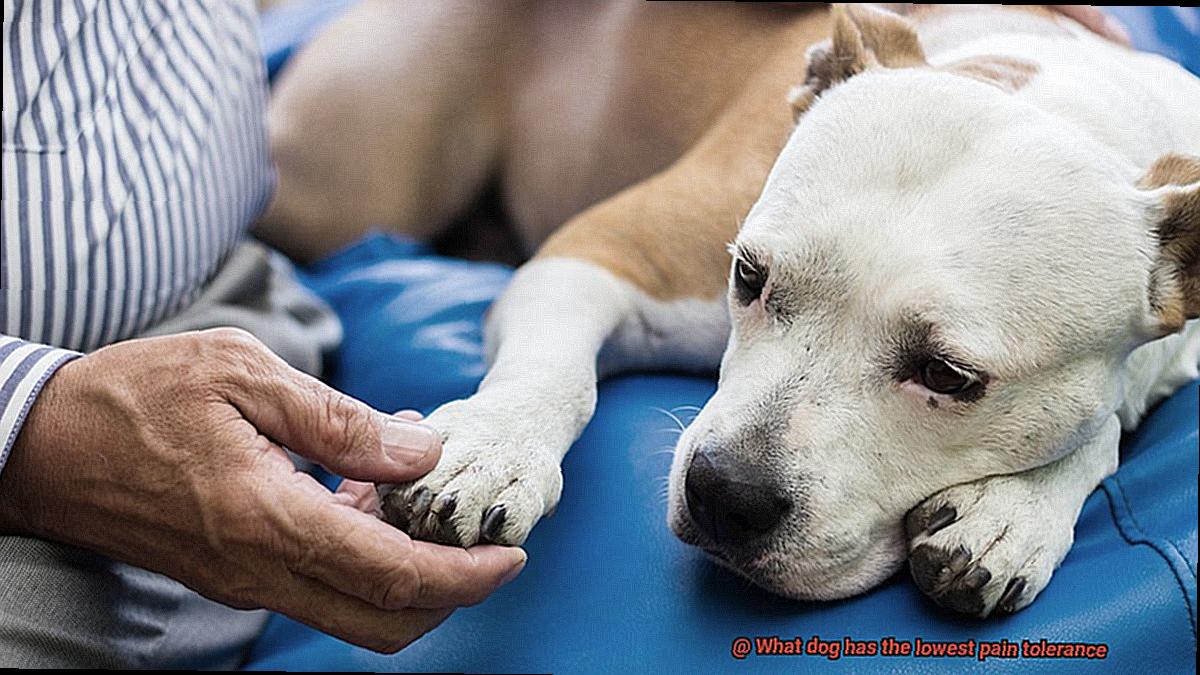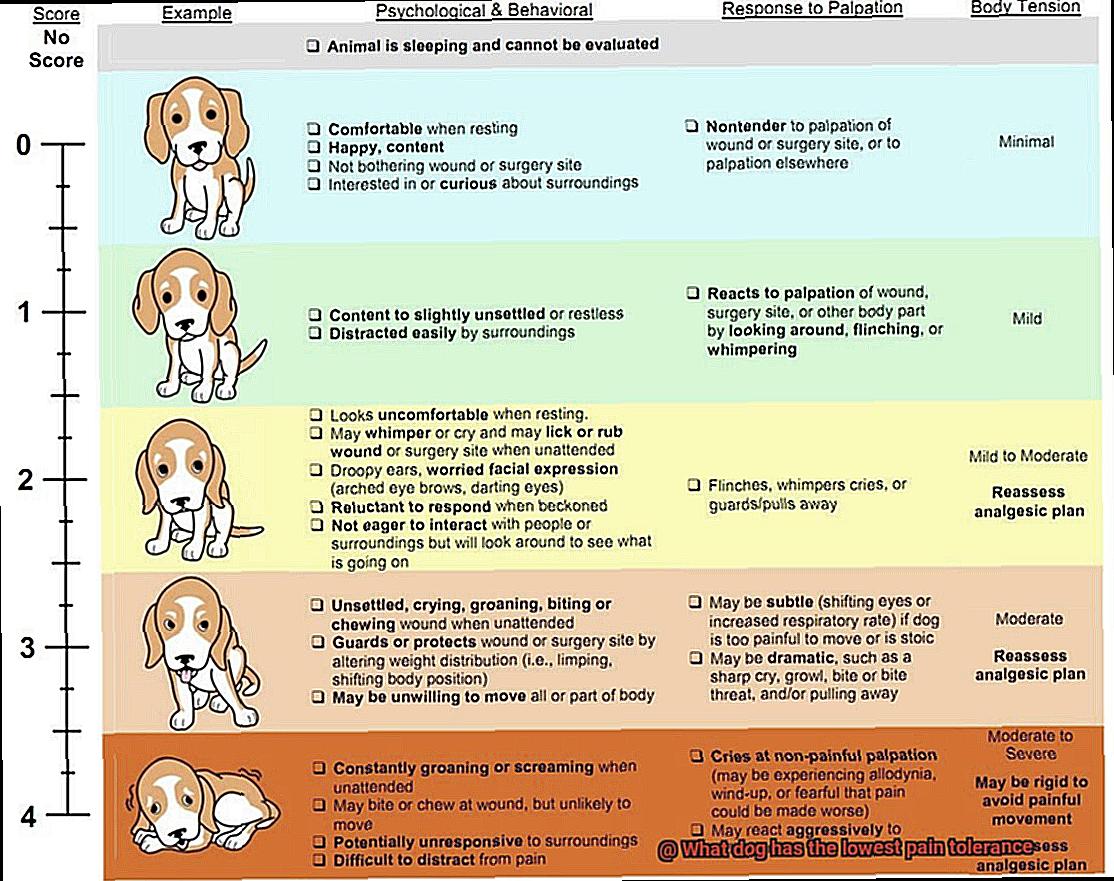What dog has the lowest pain tolerance?
Dogs, our trusty sidekicks, come in all shapes and sizes, each with their own lovable quirks. But when it comes to pain tolerance, not every pooch is cut from the same cloth. Some four-legged pals handle discomfort like champs, while others… well, let’s just say they’re a tad more delicate.
In this blog post, we’re diving headfirst into the captivating world of pain tolerance among dog breeds. We’ll be uncovering which breed might just have the lowest threshold for pain. Get ready to explore factors like size, personality, and lifestyle that shape how our furry friends perceive and react to pain.
By unraveling these mysteries, both pet parents and enthusiasts can gain a profound understanding of their fur babies’ needs when it comes to managing pain. It’s all about showering them with the tender care and compassion they deserve during those tough moments. So buckle up as we embark on this enlightening journey to discover which dog breed wears the crown for having the lowest pain tolerance.
What Breeds Have a Lower Pain Tolerance?
Contents
- 1 What Breeds Have a Lower Pain Tolerance?
- 2 The French Bulldog and Low Pain Tolerance
- 3 Health Risks of Brachycephalic Breeds and Low Pain Tolerance
- 4 Chihuahuas and Low Pain Tolerance
- 5 Factors That Can Influence a Dog’s Response to Pain
- 6 Assessing a Dog’s Pain Tolerance
- 7 Strategies for Managing and Alleviating Pain in Dogs with Low Pain Tolerance
- 8 Responsible Pet Ownership and Understanding Your Dog’s Pain Threshold
- 9 Conclusion
While pain tolerance can vary among individual dogs, certain breeds are generally considered to have a lower pain threshold. In this blog post, we’ll explore the topic of pain tolerance in dogs, with a focus on French Bulldogs and other breeds known for their sensitivity to pain.
Brachycephalic Breeds:

French Bulldogs, Pugs, and Bulldogs are brachycephalic breeds known for their adorable flat faces. Unfortunately, this facial structure can lead to various health issues and increased sensitivity to pain. Respiratory problems, joint issues, skin allergies, and spinal abnormalities are common concerns for these breeds. Due to their genetic predisposition to these conditions, French Bulldogs may have a lower pain tolerance compared to other breeds.
Small Dog Breeds:
Chihuahuas and Dachshunds are small dog breeds that often have delicate bone structures and are more prone to injuries or conditions that cause pain. Their petite size also makes them more vulnerable to external factors that can cause discomfort. It’s important for owners of these breeds to be vigilant in monitoring their dogs for any signs of distress or discomfort.
Individual Variations:
While breed characteristics play a role in a dog’s pain sensitivity, it’s essential to remember that each dog is unique. Factors such as temperament, socialization, and previous experiences can influence their response to pain. Some French Bulldogs may have a higher pain tolerance than others, just as some Chihuahuas may exhibit a stoic nature despite their breed’s reputation.
Managing Pain:
To ensure the well-being of breeds with potentially lower pain tolerance, proactive measures should be taken. Regular veterinary check-ups are crucial to identify and address any health issues promptly. Pain management strategies like medication or physical therapy may be recommended by veterinarians to alleviate discomfort.
The French Bulldog and Low Pain Tolerance
French Bulldogs, with their adorable squished faces and compact bodies, are beloved companions for many dog lovers. However, these charming little pups have a unique trait that sets them apart from other breeds – a low pain tolerance. Understanding the reasons behind their sensitivity and taking appropriate measures to ensure their comfort is essential for responsible French Bulldog owners.
Physical Characteristics:
French Bulldogs have a brachycephalic skull shape, which means their muzzle is compressed and shortened. While this gives them their distinctive appearance, it can also lead to health issues that contribute to their low pain tolerance. Their skull structure can cause respiratory problems and difficulty regulating body temperature, making them more susceptible to discomfort.
Joint and Bone Problems:
The compact and muscular bodies of French Bulldogs make them prone to joint and bone problems. Conditions like hip dysplasia and intervertebral disc disease can cause pain and discomfort in affected areas. It is important to monitor their movement and provide appropriate exercise to prevent further strain on their joints.
Skin Allergies and Sensitivities:
French Bulldogs also have a higher risk of developing skin allergies and sensitivities. These conditions can lead to itching and discomfort, causing distress for these sensitive souls. Regular grooming and proper skincare can help alleviate these issues and keep your Frenchie feeling their best.
Tips for Ensuring Comfort and Well-being:

- Regular Veterinary Check-ups: Schedule regular check-ups with your veterinarian to monitor your French Bulldog’s health, identify any potential issues early on, and ensure proper management.
- Comfortable Living Environment: Provide a comfortable living environment for your Frenchie by offering appropriate bedding, maintaining a suitable temperature, and avoiding excessive physical exertion or strenuous activities.
- Gentle Handling: French Bulldogs are sensitive to touch, so take extra care when handling them. Be gentle when cleaning their ears, trimming nails, or brushing their coat to avoid causing any pain or discomfort.
- Pain Management: In cases where pain management is necessary, consult with your veterinarian. They can recommend appropriate medications or therapies tailored to the specific needs of your French Bulldog.
Remember, being aware of your French Bulldog’s low pain tolerance is crucial for their well-being and happiness. By understanding their unique needs and taking proactive measures, you can ensure a comfortable and fulfilling life for your beloved Frenchie. After all, a happy pup is a healthy pup.
Health Risks of Brachycephalic Breeds and Low Pain Tolerance
French Bulldogs have captured the hearts of many with their charming personalities and distinctive appearance. However, it’s important for owners to be aware of the potential health risks associated with brachycephalic breeds, including their low pain tolerance. In this article, we will explore the health challenges faced by French Bulldogs and why their unique anatomy can make them more sensitive to pain.
Respiratory Issues:

Brachycephalic breeds like French Bulldogs have a skull structure that can lead to respiratory problems. Their short noses and flat faces make it difficult for them to breathe properly, resulting in increased stress and anxiety. This compromised respiratory system can also impact their ability to tolerate pain effectively.
Increased Sensitivity to Pain:
Due to their already compromised breathing ability, French Bulldogs may have a lower pain threshold compared to other breeds. When they experience discomfort or injury, their breathing difficulties can exacerbate the pain and make it harder for them to cope. It’s crucial for owners to recognize this sensitivity and take appropriate measures to minimize their dog’s discomfort.
Other Health Issues:

Aside from respiratory problems, brachycephalic breeds are prone to various other health issues. French Bulldogs may face eye conditions, dental problems, skin fold infections, and joint abnormalities. These conditions can cause pain and discomfort, further contributing to their low pain tolerance.
Prevention and Care:
To ensure the well-being of your French Bulldog, it is essential to take proactive steps in preventing health issues. Regular veterinary check-ups are crucial for early detection and treatment of any potential problems. Maintaining a healthy diet and exercise routine is also vital in managing weight and reducing strain on joints. Additionally, providing a cool and well-ventilated environment can help alleviate overheating and respiratory difficulties.
Conclusion:
As responsible owners of French Bulldogs, it’s crucial to understand the health risks associated with brachycephalic breeds, particularly their low pain tolerance. By being vigilant and proactive in their care, you can help minimize discomfort and provide a healthier and happier life for your beloved companion. Remember, knowledge is power, and by staying informed, you can make informed decisions to ensure the well-being of your furry friend.
Chihuahuas and Low Pain Tolerance
When it comes to pain tolerance, Chihuahuas are known to have a lower threshold compared to larger dog breeds. As an expert in the field, I want to provide you, French Bulldog owners, with insights into why this is the case and how you can ensure your furry friends live a pain-free life.
Size Matters
Chihuahuas are tiny creatures with delicate builds. Their small size puts them at a higher risk of injury or trauma, especially if not handled with care. So, it’s essential to handle them gently and avoid rough play that could put stress on their delicate bodies.
Sensitivity and Reactivity

Chihuahuas have a reputation for being more sensitive and reactive to pain than other breeds. This may be due to their smaller nerve endings and more delicate musculoskeletal structure. They can feel discomfort more intensely, making them more prone to reacting strongly when in pain.
Signs of Pain
Chihuahuas may exhibit signs of pain differently than larger breeds. They might yelp, tremble, or become withdrawn when experiencing pain. It’s crucial for you, as their loving owners, to be able to recognize these signs and seek appropriate veterinary care if necessary.
Common Conditions
Chihuahuas are susceptible to certain health issues that can cause pain. These include dental problems, joint issues like luxating patella or hip dysplasia, back problems such as intervertebral disc disease, and allergies. Regular veterinary check-ups can help identify and address these issues early on.
Preventive Measures
To minimize the risk of pain and injury for your Chihuahua, there are preventive measures you can take. Regular dental care is essential for maintaining good oral health. Providing a comfortable and supportive bed can help alleviate joint discomfort. And keeping your Chihuahua at a healthy weight reduces the strain on their fragile bodies.
Factors That Can Influence a Dog’s Response to Pain
French Bulldogs are adorable and playful companions, but they can also be more sensitive to pain compared to other breeds. Understanding the factors that influence their response to pain is crucial for their well-being. In this blog post, we’ll delve into the various factors that can influence a French Bulldog’s response to pain, from breed characteristics and individual variation to age, health conditions, environmental factors, socialization, and pain management strategies.
Breed:
French Bulldogs, like other brachycephalic breeds, often have a lower pain tolerance due to their unique anatomy. Their short noses and compact skulls make them prone to certain health issues, which can increase their sensitivity to pain. However, it is essential to remember that not all French Bulldogs will respond the same way to pain, as individual variation plays a significant role.
Individual Variation:
Just like humans, dogs exhibit individual variation in their response to pain. Factors such as genetics, temperament, and previous experiences with pain can influence how a French Bulldog reacts to painful stimuli. It’s important to consider each dog as an individual and tailor pain management approaches accordingly.
Age:
Puppies and senior French Bulldogs tend to have a lower pain threshold compared to adult dogs. Puppies have developing nervous systems and may be more sensitive to pain, while senior dogs may experience age-related conditions that amplify their perception of pain. Providing appropriate care and monitoring is crucial for these age groups.
Health Conditions:
Chronic illnesses like arthritis or cancer can cause ongoing discomfort and reduce a French Bulldog’s pain tolerance over time. Additionally, dogs with underlying medical conditions may already be experiencing pain, making them more sensitive to additional painful stimuli. Regular veterinary check-ups and proper pain management are vital for these dogs.
Environmental Factors:
The environment in which a French Bulldog lives can impact their response to pain. Stressful or anxiety-inducing situations may make them more reactive and increase their pain sensitivity. Providing a calm and supportive environment can help alleviate stress and improve their ability to manage painful sensations.
Socialization and Training:
Proper socialization and positive training experiences play a crucial role in a French Bulldog’s response to pain. Dogs that have been well-socialized from a young age are more likely to trust and cooperate with their human caregivers during painful procedures. Limited socialization or negative experiences may lead to fear or aggression when faced with pain.
Pain Management:
Effective pain management strategies are essential for improving a French Bulldog’s pain tolerance and overall well-being. Adequate pain relief medications and therapies can help reduce discomfort, promote healing, and enhance their quality of life. Consulting with a veterinarian is crucial to develop an appropriate pain management plan for your furry friend.

Assessing a Dog’s Pain Tolerance
As dog owners, we know that our furry friends can experience pain just like humans do. However, what many people may not realize is that different dogs can have varying thresholds for pain. This is especially true for our beloved French Bulldogs, who are known to have a lower pain tolerance compared to other breeds.
Understanding your Frenchie’s pain tolerance is crucial in providing them with the care and treatment they need. In this article, we will explore the importance of assessing a dog’s pain tolerance and the various factors that can influence it.
Why Assessing a Dog’s Pain Tolerance Matters
Assessing a dog’s pain tolerance is important because it helps us determine how much pain they may be experiencing and how they may respond to certain treatments or procedures. Dogs, like humans, can experience both acute and chronic pain.
Acute pain is typically caused by an injury or illness and is short-lived, while chronic pain can be long-lasting and may result from conditions such as arthritis or cancer. By understanding your Frenchie’s pain tolerance, you can ensure that they receive appropriate care and management for their specific needs.
Factors That Influence a Dog’s Pain Tolerance
Several factors can influence a dog’s pain tolerance. These include breed, genetics, age, individual temperament, previous experiences with pain, and overall health. While it is true that some breeds may have higher pain thresholds than others, it is important to remember that every dog is unique and may respond differently to pain. For example, French Bulldogs are known for their sensitive nature and may exhibit signs of discomfort or distress even with minor injuries or illnesses.
Assessing a Dog’s Pain Tolerance: Methods and Tools

When it comes to assessing a dog’s pain tolerance, veterinarians often use a combination of subjective and objective assessments. Subjective assessments involve observing the dog’s behavior and body language for signs of pain, such as whimpering, panting, restlessness, aggression, or changes in appetite or mobility. Objective assessments may include measuring physiological parameters like heart rate, respiratory rate, blood pressure, or cortisol levels.
There are also specific tests and tools that veterinarians can use to assess a dog’s pain tolerance. These include the Canine Acute Pain Scale (CAPS), the Glasgow Composite Measure Pain Scale (CMPS), or the Helsinki Chronic Pain Index (HCPI). These scales and indexes help veterinarians evaluate the severity of pain and monitor its progression over time.
Regular Check-ups and Communication with Your Veterinarian
Regular check-ups with your veterinarian are essential in assessing your Frenchie’s pain tolerance. During these visits, your veterinarian can evaluate your dog’s overall health and assess any potential sources of pain. It is important to communicate openly with your veterinarian about any concerns or observations you have regarding your Frenchie’s pain tolerance. They can provide guidance and recommendations for managing any pain your dog may be experiencing.
Strategies for Managing and Alleviating Pain in Dogs with Low Pain Tolerance
French Bulldogs are beloved companions known for their unique personalities and adorable appearance. However, they are also vulnerable to discomfort due to their low pain tolerance. In this article, we will explore effective strategies for managing and alleviating pain in French Bulldogs with low pain tolerance, ensuring their well-being and happiness.
Identify the Underlying Cause:
Before implementing any pain management strategy, it’s essential to identify the root cause of your Frenchie’s pain. Consult your veterinarian for a thorough examination, including diagnostic tests like X-rays or blood work. Accurate diagnosis allows for targeted treatment, enhancing your dog’s comfort.

Medications under Veterinary Guidance:
Nonsteroidal anti-inflammatory drugs (NSAIDs) are commonly prescribed to alleviate pain and inflammation in dogs. However, it’s crucial to administer these medications under veterinary guidance due to potential side effects. Your vet will determine the most suitable medication and dosage for your Frenchie’s individual needs.

Alternative Pain Management Options:
Explore alternative therapies such as acupuncture, physical therapy, or chiropractic care. These can complement traditional treatments and provide additional relief for your Frenchie. Discuss these options with your veterinarian to ensure they are suitable for your dog’s specific condition.
Environmental Modifications:
Creating a comfortable and stress-free environment is vital for managing pain in French Bulldogs. Provide soft bedding that supports their joints and consider elevated feeding stations to reduce strain on their necks. Ramps or stairs can assist them in accessing elevated surfaces without exerting unnecessary effort.
Behavior Monitoring:
Pay close attention to changes in your Frenchie’s behavior, appetite, or mobility. These may indicate increased pain or discomfort. Regular communication with your veterinarian is crucial as they can adjust the pain management plan accordingly.
Emotional Support:
Offering emotional support is as important as physical pain management. Spend quality time with your Frenchie, engaging in activities that provide mental stimulation. Gentle massages or grooming sessions can also help distract them from pain and promote overall well-being.
Consultation with a Veterinary Behaviorist:
In severe cases where traditional pain management strategies are insufficient, a veterinary behaviorist can provide additional insights. They specialize in addressing anxiety and fear related to pain, offering behavior modification techniques tailored to your Frenchie’s needs.
Responsible Pet Ownership and Understanding Your Dog’s Pain Threshold
French Bulldogs are adorable and popular companions known for their friendly nature and unique appearance. However, it is crucial for owners to understand that they have a relatively low pain threshold compared to some other breeds. Responsible pet ownership includes recognizing and managing your French Bulldog’s pain threshold to ensure their well-being and happiness. In this blog post, we will explore effective strategies for understanding and addressing your French Bulldog’s pain.
Identifying Underlying Causes
The first step in managing your French Bulldog’s pain is to identify any underlying causes. This can be done through regular veterinary check-ups and screenings. By detecting potential health issues early on, you can address them promptly and minimize your dog’s discomfort.
Common conditions that may cause pain in French Bulldogs include hip dysplasia, spinal problems, and respiratory issues. Be observant of any changes in your dog’s behavior, such as reluctance to move or play, excessive licking or chewing on a specific area, or vocalization. These signs may indicate that your French Bulldog is experiencing pain and should prompt a visit to the veterinarian.
Medication Options
Once the underlying causes of your French Bulldog’s pain have been identified, your veterinarian may recommend medication to alleviate their discomfort. It is essential to follow your vet’s guidance closely when administering medication to ensure the correct dosage and frequency. Never give your dog human medication without consulting a veterinarian first, as some substances can be toxic to dogs.
Alternative Therapies
In addition to medication, there are alternative therapies that can help manage your French Bulldog’s pain. These include acupuncture, physical therapy, massage, and hydrotherapy. These therapies can provide relief and improve your dog’s overall well-being. However, always consult with a trained professional before trying any alternative therapies to ensure they are safe and suitable for your French Bulldog.
Environmental Modifications
Creating a comfortable and safe environment for your French Bulldog is crucial in preventing pain and injury. Ensure that their living space is free from hazards and provide them with a cozy bed that supports their joints. Avoid exposing them to extreme temperatures, as French Bulldogs can be sensitive to heat and cold.
Monitor Behavior Closely
As responsible pet owners, it is important to closely monitor your French Bulldog’s behavior for any signs of pain or discomfort. If you notice changes in their activity level, appetite, or behavior, it may indicate that they are experiencing pain. Take note of these changes and consult with your veterinarian for further evaluation.
Offer Emotional Support
Just like humans, dogs can benefit from emotional support when they are in pain. Provide your French Bulldog with love, attention, and comfort during this time. Be patient and understanding, and offer gentle reassurance to help alleviate any anxiety or stress they may be experiencing.
Conclusion
In conclusion, when it comes to the question of which dog has the lowest pain tolerance, it is important to consider various factors. While all dogs have their own unique pain thresholds, some breeds are known to be more sensitive than others. It is crucial for dog owners and caregivers to be aware of this and take extra precautions when handling these breeds.
One such breed that often stands out in terms of low pain tolerance is the Chihuahua. Despite their small size, Chihuahuas can be quite sensitive to even minor discomfort. Their delicate frames and sensitive nature make them prone to experiencing pain more intensely than larger breeds.
Another breed that deserves mention in this discussion is the Shih Tzu. These adorable little dogs may appear resilient, but they actually have a relatively low pain threshold. This means that even seemingly minor injuries or procedures can cause them significant distress.
It’s also worth noting that individual dogs within any breed can vary in terms of their pain tolerance. Factors such as genetics, past experiences, and overall health can influence how a dog perceives and reacts to pain.
Therefore, it is crucial for dog owners and professionals alike to approach any situation involving potential pain with sensitivity and caution. This includes regular veterinary check-ups, proper training techniques, and providing a safe environment for our furry friends.
In conclusion, while there isn’t a definitive answer as to which dog has the absolute lowest pain tolerance, certain breeds like Chihuahuas and Shih Tzus are generally considered more sensitive.




